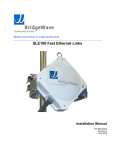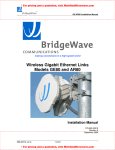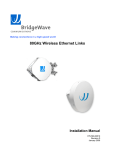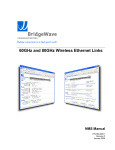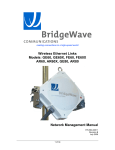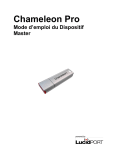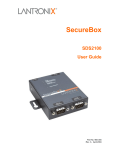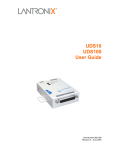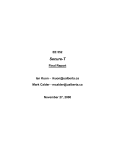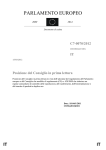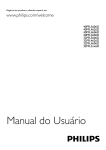Download BridgeWave AR60X User's Manual
Transcript
Making connections in a highspeed world AR60X Wireless Ethernet Links Installation Manual P/N 58000517 Revision B January 2008 AR60X Installation Manual Copyright Notice & Disclaimer Copyright © 2004 2008 BridgeWave Communications. All rights reserved. Printed in the USA No portion of this publication may be reproduced, copied, or distributed without the written consent of BridgeWave Communications. BridgeWave reserves the right to update or change the material in this publication at any time without notice. BridgeWave has made every effort to ensure that the information and the instructions contained in the publication are adequate and is not responsible for any errors or omissions due to typing, printing, or editing of this document. Purchasers of BridgeWave products should make their own evaluation to determine the suitability of each such product for their specific application. BridgeWave’s obligations regarding the use or application of its products shall be limited to those commitments to the purchaser set forth in its Standard Terms and Conditions of Sale for a delivered product. This publication has been prepared for professional and properly trained personnel, and the customer assumes full responsibility when using the information herein. Export Control All BridgeWave radio products are restricted commodities that fall under ECCN 5A002 of the Department of Commerce. These products are "ENC restricted" under section 740.17(b)(2) of the Export Administration Regulations (EAR). BridgeWave products may only be exported, re exported, transferred, or retransferred in accordance with Export Administration Regulations. Diversion contrary to U.S. law is expressly prohibited. Product Compatibility While every effort has been made to verify operation of this product with many different communications products and networks, BridgeWave makes no claim of compatibility between its products and other vendors’ equipment. It is assumed that users have thoroughly evaluated this product’s performance in the communications environment in which it will be used. 58000517, rev B ii AR60X Installation Manual Safety CAUTION, WARNING, and DANGER statements have been strategically placed in the text to alert personnel of possible hazards. These statements must be closely observed. The following general safety precautions must be observed during all phases of operation and service of the products covered in this manual. Failure to comply with these precautions or with specific warnings elsewhere in this manual willfully violates standards of design, manufacture, and intended use of the product. BridgeWave assumes no liability for the customer’s failure to comply with these requirements. · These BridgeWave radios meet all applicable FCC safety requirements for general population exposure to radio frequency emissions; however, it is best to avoid prolonged, unnecessary exposure to the front of the radio while it is operating. · The outdoor equipment must be properly grounded to provide some protection against voltage surges and builtup static charges. In the event of a short circuit, grounding reduces the risk of electrical shock. For installations in the U.S.A., refer to Articles 810830 of the National Electrical Code, ANSI/NFPA No. 70, for information with respect to proper grounding and applicable lightning protection for DC cables. The installer must also follow any additional local building and electrical code regulations. For installations in all other countries, implement protection in accordance with the safety standards and regulatory requirements of the country where the equipment is to be installed. · Do not install or operate this equipment in the presence of flammable gases or fumes. Operation of any electrical instrument in such an environment constitutes a definite safety hazard. · Do not install substitute parts or perform any unauthorized modification to the equipment. Changes or modifications not expressly approved by BridgeWave can void the user’s authority to operate the equipment. iii 58000517, rev B AR60X Installation Manual Regulatory Information This device complies with FCC Part 15.255 and Industry Canada RSS210. Operation is subject to the following two conditions: (1) This device may not cause harmful interference, and, (2) This device must accept any interference that may cause undesired operation. Equipment Precautions Water and Moisture All AR 60X links are designed to withstand weather conditions typically encountered when installed outdoors. Power Sources This product should only be operated with the type of power source provided by BridgeWave Communications Inc. 58000517, rev B iv AR60X Installation Manual Table of Contents Copyright Notice & Disclaimer...................ii Export Control............................................ii 3 Product Compatibility.................................ii Safety........................................................ iii Regulatory Information.............................. iv Equipment Precautions .............................. iv 1 2 Introduction...........................................0 Installation ............................................ 8 3.1 General........................................... 8 3.2 Equipment Unpacking..................... 8 3.3 Equipment Inventory....................... 9 3.4 Installation Tools.......................... 10 3.5 Antenna Mount Installation........... 11 3.6 Antenna and Radio Installation..... 14 1.1 Purpose of Manual ..........................0 3.7 Cable Installation ......................... 18 1.2 Prior Knowledge .............................0 3.8 Ice Shield Canopy Installation ...... 21 1.3 Contact Information ........................1 3.9 Antenna Alignment........................ 24 3.10 QUAL and RSL Test Cable............ 27 Site Planning..........................................2 2.1 General ...........................................2 2.2 Equipment Checklist........................2 2.3 Line of Sight (LOS)..........................2 2.4 Link Distance ..................................3 2.5 Antenna Location ............................3 Appendix A: Troubleshooting ................... 30 2.6 2.8 Cabling ...........................................4 Appendix B: RSL Voltage vs. Distance ..... 32 Grounding & Lightning ...................5 Std. Limited Warranty & SW License ...... 33 Environmental.................................6 2.9 Cabling Diagram ............................7 2.7 4 Radio Link Status Indicators ............. 28 5 Connecting Network Equipment........ 29 5.1 v Network Port Statistics.................. 29 58000517, rev B AR60X Installation Manual 1 Introduction 1.1 Purpose of Manual The information in this manual is directed to persons who must perform or coordinate the tasks associated with the process of installing wireless communication devices, and planning communication network applications. 1.2 Prior Knowledge This manual assumes the operator has at least basic experience with and an understanding of wireless technology and some familiarity with configuring and operating networking equipment. Preferably, the person installing this equipment fully understands the information covered in this manual prior to attempting these procedures. DANGER, WARNING and NOTE statements have been placed in various sections throughout this document to alert personnel of possible traffic affecting issues and to provide additional tips and helpful information. These statements should be closely observed. Symbol Description Indicates that personal injury can result if the user does not comply with the given instruction. A DANGER statement will describe the potential hazard, its possible consequences, and the steps to perform to avoid personal injury. Indicates that equipment damage, process failure and/or loss of data can result if the user does not comply with the given instructions. A WARNING statement will describe the potential hazard, its possible consequences, and the steps to perform to avoid serious equipment damage. Provides supplementary information to emphasize a point or procedure, or provides a tip for easier operation. 58000517, rev B 0 AR60X Installation Manual 1.3 Contact Information Technical Assistance and Customer Service BridgeWave distributors are authorized local service providers and are responsible for immediate customer support. If problems are not resolved, contact BridgeWave Customer Service for assistance: Santa Clara, CA USA Tel: 408.567.6906 Fax: 408.567.0775 Email: [email protected] Return Material Authorization (RMA) Should BridgeWave equipment have to be returned for repair or replacement, an RMA number must be obtained from BridgeWave or the local BridgeWave distributor. When returning equipment, be sure to write the RMA number on the outside of the shipping carton. BridgeWave Sales Email: [email protected] Inside Sales: +1.866.577.6908 1 58000517, rev B AR60X Installation Manual 2 Site Planning 2.1 General Before the start of an installation a survey should be conducted of the proposed area of the site(s). The survey personnel should be fully familiar with the details required to install the BridgeWave radio system. 2.2 Equipment Checklist The survey team will need at least the following equipment: · · · · · Binoculars GPS Navigation Device Tape Measure Site Survey Report Form Level 2.3 Line of Sight (LOS) BridgeWave Wireless links require lineofsight for proper operation. Fortunately, the links are relatively short and obstructions in the path can easily be identified. Binoculars can ease viewing in poor light conditions. The planning should include an investigation into future building plans that could block the LOS path, and other longterm incremental obstructions such as trees. Intermittent obstructions such as aircraft at a nearby airport should also be considered. The following table details the minimum clearance needed from obstacles near the path in order to ensure the radios will operate properly. Path Length (meters) 250 500 750 1000 1500 2000 Minimum Clearance (meters) 0.56 0.79 0.97 1.12 1.37 1.58 Table 21: Minimum Clearance at Link Midpoint for various Path Lengths 58000517, rev B 2 AR60X Installation Manual 2.4 Link Distance Measurement of the link distance is important in estimating the link availability and calculating expected Receive Signal Level (RSL). This measurement can be performed using the Latitude and Longitude readings from a Global Positioning System (GPS) device, which is placed near the proposed locations of the antennas, or using a range finder device. The Minimum Link Distances are as follows: · AR/GE/FE 60: 65 feet (20 meters) · AR60X: 330 feet (100 meters) To estimate maximum distances and availabilities for a given product and region, BridgeWave’s Path Availability Calculator can be used. To obtain the latest version of BridgeWave’s Path Availability Calculator, contact BridgeWave’s Customer Service or search the eService center knowledgebase 2.5 Antenna Location The optimum location for the antennas must be determined. The ideal location should provide for ease of erecting and mounting the antenna, as well as unimpeded LineOfSight (LOS) to the other site. The following factors should be taken into account: · Type of mounting—fixed or roofsafe pole mounting · Location where the fiber and DC power wiring will enter/exit the building · Length of cable runs · Grounding connection points · Obstructions (LOS) · Accessibility of mounting location · Access to building after regular working hours 3 58000517, rev B AR60X Installation Manual 2.6 Cabling The installation site should be inspected to determine the run paths for the fiber cable and power cable from the radio equipment to the termination point. Locations for roof penetration should be identified. The routing and securing of all cables should conform to all applicable codes and requirements. Depending on the likelihood of damage due to foot traffic or equipment movement, cabling conduit may be required. The maximum cable run length as specified for the equipment being installed must not be exceeded. The radio requires an LC type connectors on a pair of simplex multimode fibers to properly connect to the radio and the users network equipment. Singlemode fiber is not a current option supported by the radio. The network equipment end of the fibers should be terminated with connectors that match the network equipment fiber interface. Fiber Cable Length Up to 270 meters Up to 500 meters Cable Type 62.5/125 μm 50/125 μm Table 25: Fiber Cable Types Each radio includes a 100240 VAC power adaptor suitable for indoor operation that converts the AC voltage from the standard electrical outlet in the wall to DC voltage. The radio requires a minimum of 15.0 VDC (24.0 VDC maximum) via the power cable to the radio to function properly. When planning the cable run from the indoor mounted AC power adaptor to the radio unit, it is critical to use the cable gauge (AWG) indicated below to ensure adequate voltage at the radio. The electrical cable that is used outside the building must be outdoor rated (i.e., weatherprotected) providing a single pair of wires necessary to power the equipment. The required DC power cable is 12 or14 gauge, 2 wire (i.e., 12/2 or 14/2) rated for outdoor use. DC Cable Length Up to 125 meters Up to 200 meters Minimum Cable Size Outside Diameter of DC Cable Jacket (minmax)* Conductor size 0.14 – 0.36 inches 14 AWG (3.6 – 9.2mm) (2.5mm 2 ) 0.17 – 0.45 inches 12 AWG (4.3 – 11.9mm) (4mm 2 ) Table 26: Minimum DC Cable Size The DC cable must comply with local building and/or electrical codes in your area. 58000517, rev B 4 AR60X Installation Manual Figure 23 (left) details a standard 14gauge wire that has been fitted with the power connectors (provided) for the radio’s internal power supply necessary to mate with the provided power cord. A standard crimping/splicing tool (not provided) is required to terminate the power connectors onto the 14gauge cable required for use with the unit. Figure 23: 14gauge DC power cable with crimp connectors In addition to grounding the equipment, BridgeWave strongly recommends, and local building codes may require, that the power cable be protected from lightning strikes. If a copper Cat5 Ethernet cable is used for Network Management access, it is also necessary to install surge suppressors at each end of this cable. A surge suppressor must be placed within the radio enclosure (to protect the radio electronics) and at the building exit/entrance (to protect the indoor equipment). BridgeWave recommends the Dehn Patch DPA M CAT6 RJ45S 48. 2.7 Grounding & Lightning Proper grounding of the outdoor equipment reduces electromagnetic interference, provides lightning protection, and protects against electrical discharge. Using improper techniques in lightning prone geographic areas may pose a danger to local personnel. The source and connection points for the buildingtoearth ground in the vicinity of the antenna location should be determined. It is recommended to integrate the radio ground into the building ground utilizing the pole mount hardware. For wall or ungrounded pole mounts connect a grounding wire to the grounding point on the radio. Select the size of the ground wire based on the National Electrical Code. In addition to grounding the equipment, BridgeWave strongly recommends, and local building codes may require, that the DC electrical cable be protected from lightning strikes with a surge 5 58000517, rev B AR60X Installation Manual suppressor. The surge suppressor must be installed at the point where the DC electrical cable exits/enters the building, however, the use of a surge suppressor at the radio unit is optional since power cable surge suppression is built into the unit. If a copper Cat5 Ethernet cable is permanently installed, it is necessary to install surge suppressors at both ends of this cable. A surge suppressor must be placed within the radio enclosure (to protect the radio electronics) and at the building exit/entrance (to protect the indoor equipment). For more information on recommended accessory devices and kits, contact BridgeWave Sales 2.8 Environmental The structure to which the equipment will be mounted must be adequate to bear all wind and weather conditions. The wind load at high wind velocities can exceed 100 ft/lb of torque, BridgeWave highly recommends pole diameters of 3” or more. The environmental conditions at the location must conform to the operating environment specified for the equipment. 58000517, rev B 6 AR60X Installation Manual 2.9 Cabling Diagram Following is a diagram detailing the equipment and cabling found on a typical installation of BridgeWave’s 60GHz radio equipment. 7 58000517, rev B AR60X Installation Manual 3 Installation 3.1 General It is recommended that installation personnel read this section in its entirety prior to installing the BridgeWave System. During a particular phase of installation, the user may refer directly to the applicable subsection. The Installation section is comprised of seven subsections covering the procedures and guidelines for installing the BridgeWave Radio System. Subsections 3 through 3.4 contain information necessary to prepare for the equipment installation. Subsections 3.5 through 3.8 covers equipment installation procedures. Subsections 3.9 and 3.10 contains information necessary for aligning the antennas. 3.2 Equipment Unpacking The radio system equipment will arrive in two boxes—one box for the low band radio and one box for the high band radio. Locate the correct box (low band or high band) before beginning installation by checking the label on the outside of the box or on the radio itself. It is recommended that the shipping cartons and packing materials be retained in the event that it is necessary to return any equipment. Unpacked radios can be identified by the color of their labels found on their front faces or inside the unit after removing the plastic back weather cover. The blue color label indicates a high band radio and the red color label indicates a low band radio. See Figure 35 for further details. 58000517, rev B 8 AR60X Installation Manual 3.3 Equipment Inventory Each carton is accompanied by a packing list. Verify the contents of the carton against the packing list. Following are inventory lists for a typical system. Qty Description 2 ea. AR60X radios (1 lowband & 1 highband) 2 ea. Standard Power Supply (Indoor rated, 100240VAC input to 24VDC output) 2 ea. Pole mount kits 1 ea. CD with Manuals (1 CD provided per pair of radios) 2 ea. DC power connection set. (Includes 2prong DC plug and 2 ea slip fit plugs/receptacles) 2 ea. Antennas (radios are attached to back of antenna in vertical polarization) 1 ea. Hard reset box AR60X Antenna and Mount Kit Parts List Item 1 2 3 4 5 6 7 8 Description Antenna Lower Pole mount assembly Qty. 1 1 Upper Pole mount assembly Antenna mounting plate 1 3/8 bolts 3/8 lock washers 3/8 flat washer 3/8 nylon washer 2 2 2 2 1 Figure 31 The radio is sealed at the factory warranty stickers on the inner (metal) cover of the radio. There is no need to open this cover in the field. Tampering with these seals will void the warranty. 9 58000517, rev B AR60X Installation Manual 3.4 Installation Tools The following tools, not provided by BridgeWave, are required for installing the radio and the antenna: Screwdriver, slotted 0.1 inch (2.5mm) wide Openend wrench 11/32 (9mm) Openend wrench 9/16 (14mm), 2 ea. Openend wrench 1/2 (13mm) Ratchet with 6 inch (15cm) extension and 9/16 inch (14mm) deep socket Wire stripper/cutter/crimp tool (1016 gauge) Electrical tape Fish tape for pulling cable Cable tie wraps Level Handheld DVM (digital voltmeter) with standard banana plug receptacles 58000517, rev B 10 AR60X Installation Manual 3.5 Antenna Mount Installation 1. Read these instructions before beginning installation. Caution should be used. Qualified persons experienced with antenna assembly and installation are required for installation. 2. BridgeWave Communications Inc. disclaims any responsibility or liability for damage or injury resulting from incorrect or unsafe installation practices. 3. The antenna has been formed to a very close tolerance parabolic shape. Careful handling and assembly is required to avoid denting the reflector, which would degrade antenna performance. 1. Attach the upper pole mount. Confirm that the Mount is centered as shown. Tighten bolts Securely Figure 32 11 58000517, rev B AR60X Installation Manual 2. Attach the lower pole mount as shown. Hardware: Flat washer, bushing (inside eye), flat washer, lock washer, bolt. Figure 33 Confirm that the Mount is centered as shown. Tighten bolts securely Figure 34 58000517, rev B 12 AR60X Installation Manual 3. Completed installation of pole mount with right hand offset for the antenna. Note the position of the elevation adjust hex nut. Figure 35 4. Optional left hand antenna offset mount preparation. Remove bolts rotate the antenna mounting plate 180º replace bolts tighten bolts securely Note the new position of the elevation adjust hex nut. Figure 36 When using the left side radio mount position, the antenna drain plugs must be rotated to the top drain holes and the bottom holes must be open to allow for proper drainage. 13 58000517, rev B AR60X Installation Manual 3.6 Antenna and Radio Installation 5. Install – Antenna Slip antenna over pivot pin, ensuring that the elevation adjust pin is engaged with slot in adaptor plate. Secure the antenna with two (2) x 3/816 bolts, lock washer, flat washer and nylon washers attach antenna to the alignment plate. Figure 37 When the radios come from the factory, they are mounted on the back of the antenna in the vertical polarization position, that is, the diamond marking (see figure 38 below) on the front of the radio housing is to the right when viewed from the front of the radio. For horizontal polarization, the radio needs to be removed from the antenna and rotated so the diamond is at the top when viewed from the front. 58000517, rev B 14 AR60X Installation Manual Figure 38: Polarization diamond orientations: vertical (left) and horizontal (right) The blue color label indicates a high band radio and the red color label indicates a low band radio It is critically important during installation to ensure the radios on each side of the link are in the same polarization (horizontalhorizontal or verticalvertical). A link that has a radio on one side of the link set in the horizontal polarization and the other side of the link set in the vertical polarization will not operate properly. It is also critically important that a highband radio is paired with a lowband radio to ensure the system will operate properly. Prior to installation check each radio to verify one is a highband and the other is a lowband version. The label on the radio will indicate the band (blue for high or red for low). 6. Verify that the four (4) captive 3/816 bolts with lock and flat washer are in place. A ½ inch openend wrench is required to tighten them. It is important that all four screws are tightened evenly (hand tight, 1 to 2 turns each and finally until the lock washer is flattened) Figure 39 Captive radio bolt detail 15 58000517, rev B AR60X Installation Manual 7. Attach the radio to the back of the antenna and tighten the four (4) bolts. See 6. for details. Figure 310 Attaching the radio to the back of the antenna 8.Adjust azimuth (Side to Side) 1. Loosen the 4 Azimuth lock bolts 3. Secure the 4 Azimuth lock bolts (tighten until lock washers are flattened) 2. Adjust eyebolt length using a 9/16 openend wrench to required location Figure 311 Azimuth (right/left) alignment 58000517, rev B 16 AR60X Installation Manual It is very important that the azimuth bolts are tightened before any elevation adjustment is done. The very narrow beamwidth of this antenna (0.6º) makes it necessary to completely tighten the bolts of the azimuth adjustment while adjusting the elevation and vice versa. 8. Adjust elevation (up down) 2. Rotate Elevation adjust hex nut as required to set correct elevation. 1. Loosen (2) antenna mounting bolts 3. Tighten all bolts after the elevation is set. Figure 312 Elevation (up/down) adjustment Begin the alignment process with the antenna in a level attitude. When adjusting elevation, it is better to start in a low attitude and raise the antenna to the proper position than to start high and work towards a low elevation setting. 17 58000517, rev B AR60X Installation Manual 3.7 Cable Installation Fiber Cabling 1. Install a pair of multimode fibers (850nm) from the radio to the network termination equipment (switch or router with 1000BaseX port). The cable should be looped around the inside of the enclosure to provide strainrelief. Do not connect the fibers to the radio’s fiber ports at this time. The connectors on the radio end of the fibers require simplex LC connectors; the connectors on the switch/router end should be chosen to correctly mate to the network equipment sockets. The simplex LC connectors for the radio need to be inserted individually through the slipfit connectors on the radio, as there is not sufficient room for both to fit through at the same time. If you have a duplex hood joining the LC connections, it should be temporarily removed during this process. 2. Connect fibers at the network equipment. It is important not to connect the fibers to the radio until after aligning the radio as the radio performs an automatic calibration once the fiber is inserted into the radio and this calibration will not operate properly if the radio is not properly aligned. If this inadvertently occurs while the radio is powered on, unplug the fibers and power cycle the radio. Power Cabling 1. Select indoor location for the AC power adaptor, with easy cable routing to the radio. Normally it is convenient, but not required, to place the adaptor near the network termination equipment. 2. Ensure the DC wire used is 14gauge type and no longer than 125 meters; or 12gauge and no longer then 200 meters. 3. Connect the provided DC Connectors onto the 14guage wire using a splicing/crimping tool. For the use of 12gauge wire it may be necessary to trim a few strands from the ends of thicker stranded cables to more easily fit the crimp connectors. 4. Install the DC power cable and attach to the AC adaptor using the supplied crimp connectors. Do not connect the power jack to the radio at this time. Be sure to first connect the DC power connectors before inserting the power plug into the power jack in the radio. Minor electrical sparks may be noticed if the sequence above is not followed; however, these sparks are normally harmless. 58000517, rev B 18 AR60X Installation Manual Optional Copper Ethernet Cabling Normally, only the fiber cable is used to carry network traffic to the indoor network equipment. In special cases, it may be necessary to use a 10/100BaseT copper connection to the indoor equipment (or other outdoor network equipment), in which case special care must be taken to protect both the radio unit and the indoor equipment from electrical surges. Surge suppressors are not needed for temporary connections while installing or troubleshooting a link when lightning is not a risk. 1. Install a Cat5 type Ethernet cable from the radio to the network termination equipment (switch or router with 10/100BaseT port). The cable should be looped around the inside of the enclosure to provide strainrelief. Connect the Ethernet cable to the surge suppressor placed within the radio housing and then connect a cable from the other end of the surge suppressor to the radio’s 10/100BaseT port. The RJ45 connector for the radio needs to be inserted separately from the fiber and DC cable through the ¾inch conduit fitting on the radio, as there is insufficient room for all to fit through at the same time. 2. Install a second surge suppressor at the building entrance/exit. This may require the use of RJ45 Female/Female couplers. Connect Ethernet cable to the network equipment used for network management. Figure 313: Back view of vertically polarized unit. 19 58000517, rev B AR60X Installation Manual Figure 314: Inside view of fiber, power and Cat 5 cable connected The fiber cable is inserted through the fitting before the conduit is connected to the fitting. Ensure that the cables do not get pinched when the conduit is pushed onto the fitting. Both the cables have been looped around the inside of the enclosure to minimize tension on the cables when connected to the radio and to maintain proper bendradius of the fiber cable. Ground Cabling The preferred method for grounding the radio unit is to ground the mast (or wallmount bracket) to a ground source, since this provides the largest grounding surface contact possible. If this is not possible, then use the following procedure: 1. Attach the lug of the ground cable (not provided) with the radio to one of the two #8 holes at the bottom of the radio using a #832 x ½” long bolt, #8 lock washer and #8 flat washers (not provided). 2. Connect other end of the ground cable to a nearby building exterior ground location. 58000517, rev B 20 AR60X Installation Manual 3.8 Ice Shield Canopy Installation The Ice Shield assembly is an optional item and can be ordered in kit form through a BridgeWave distributor. 3.8.1 Introduction In northern climates, the buildup of ice or snow on antennas can be a problem for millimeter wave radio installations. These problems are twofold: the electrical effect of snow and ice built up on the antenna’s radome; and the mechanical impact of the additional weight of the snow or ice on the antenna and supporting structure. The formation of ice or snow on the antennas radome can cause attenuation of the signal to the point where the link may become severely degraded or unusable. Uneven ice buildup can cause scattering of the signal, which in turn results in standing waves. Ice layers are not likely to exist for extended periods, as ice tends to melt. In cold climates when the radome is below freezing temperature, ice does not stick to it, thus there is no issue. However in mixed rainsnowice storms, ice can stick to the radome, causing the link to operate at less than its optimal design. Once the ice has hardened and freezes, the added weight of the ice on the antenna increases the wind load on the tower or mast, which may cause premature failure of the mounting structure. As ice breaks apart due to melting, or via its own weight, these large and heavy sheets falling down a tower or mast can cause damage to antennas or other objects mounted below. BridgeWave provides an ice shield kit, designed to combat the buildup of ice on BridgeWave’s wireless bridges. These inexpensive ice shields are easily fitted on the radios during the installation process. 21 58000517, rev B AR60X Installation Manual Figure 3.8.11: 60X Ice Shield 3.8.2 Optional Kit The part number for this kit is 51500529 (Available through Sales, see contact information section) Refer to the table below for the kit required for your particular application. Each kit contains the necessary materials for the installation of the ice shield on one radio. Two kits are required per link. Qty: Description: 1 ea. Ice Shield Canopy 1 ea. Ice Shield Clamp, 6’ 3.8.3 Installation Instructions 1. Remove the protective liner from the plastic canopy. 2. Use a screwdriver or 5/16” nut driver to set the hose clamp to the end of its range for maximum opening. 3. Slip the hose clamp over the radome so that it loosely sits in approximately the middle of the radome. 4. Slide one end of the plastic canopy under the clamp and slowly bend it around the canopy and work it under the rest of the clamp. 58000517, rev B 22 AR60X Installation Manual 5. Align the canopy to the back edge of the radome and position the clamp 1 to 3” away from the edge. 6. Tighten the clamp until snug. (Do Not Overtighten) Remove canopy when its not snowing to reduce antenna wind loading 23 58000517, rev B AR60X Installation Manual 3.9 Antenna Alignment 1. Finish the installation as described in Chapter 3.6 and 3.7 2. Ensure fiber cables are still disconnected! 3. Connect DC power to the radio. 4. Verify that the Power LED is lit. If the Power LED is not lit, use voltmeter to verify correct voltage and polarity at radio. To reverse the power polarity, unplug the power jack and swap the two conductors. 5. Repeat steps 1 through 4 on other side of the link. 6. Connect QUAL and RSL test cable to the radio. 7. Slightly rotate each antenna up/down and left/right to find the maximum RSL voltage reading. To ensure that the antennas are not aligned on a sidelobe, they must be rotated at least ten degrees on each side of the visuallyperceived alignment center to ensure that the true maximum RSL voltage is found; note that the width of the center beam is only 0.6 degrees and the first sidelobe beam is only 1.5 degrees off from center. Set the antenna in the position that results in the highest RSL voltage reading. See Section 3.9 to determine the proper use of the supplied test cable in order to read the RSL voltage. Verify that the RSL voltage falls within the expected range based on the graph in Appendix B. 8. Ensure all bolts are tightened securely and the RSL voltage remains unchanged during tightening. Keep in mind that it is very important that the azimuth bolts are tightened before any adjustment on the elevation is done. The very narrow beamwidth of this antenna (0.6º) makes it necessary to completely tighten the bolts of the azimuth adjustment while adjusting the elevation and vice versa. 9. Connect the fiber cable to one of the radios at a time. The fibers should already be connected to active network equipment. If the unit is not to be connected using fiber cabling, a temporary loopback fiber must be used to perform this operation. 10. Verify the Fiber LED’s on each radio are illuminated solid. The fiber integrity indication on the network equipment could show up or down independent of the link status. Once the radio link is up and network equipment connected on both sides of the link the network equipment should indicate fiber integrity. 58000517, rev B 24 AR60X Installation Manual 11. Once the fiber is connected to the radio, the radio will begin an internal link calibration. During this time the Link Up LED will blink for approximately 120 seconds for the AR60X. 12. Wait until the Link Up LED is lit solid on both radios. 13. Verify the Link Quality voltage is 3.3V (i.e., error free). Repeat steps 1013 for the second radio. When a radio is power cycled, it will execute a limited version of the calibration process. After this time, the link should be functioning. This limited automatic calibration process is also activated if the link is down for more than 5minutes . 14. Remove the test cable from the radio, replace the rear plastic cover and use a wrench to tighten the back cover nut to the point where the back cover stops (i.e., when it hits the metal ring on the back metal plate). The installation is now complete. Auto Calibration States State Unit powered up no fiber connected Unit powered up then fiber cable connected for the first time Normal operation mode Forced Recalibration Description Unit will be in alignment mode, there will be no automatic calibration event started until the fiber is connected The radio will perform a single calibration scan and will then go into normal operation mode, regardless of the results of the scan. (Link up or down status has no influence on the scan) Disconnecting and reconnecting the fiber cables will not cause a recalibration. A recalibration will only happen if the link is down for more then 50 seconds. Power cycling the radio and disconnecting then reconnecting the fiber to the powered up radio will start the auto calibration routine again. If the fiber cables stay disconnected the radio will go back into alignment mode. 25 58000517, rev B AR60X Installation Manual 3.3 Correctable Errors Detected 3.0 QUAL Voltage (VDC) NO ERRORS 2.0 Uncorrectable Errors Detected 1.7 CORRECTED ERRORS UNCORRECTED ERRORS 0.3 Deframer Unlocked (Link Down) 0.0 0 0 Errors Figure 310 Quality Voltage Graph · Quality Voltages between 3.0V and 3.3V indicate an errorfree wireless link. · Quality Voltages between 1.5V and 3.0V indicate a low rate of errors, that the forward error correction will correct. The lower the voltage, the more errors are being corrected. · Quality Voltages between 0.5V and 1.0V indicate excessive errors in the wireless link that can not be corrected by the FEC. To indicate this change in error performance, the quality voltage will drop from 1.5V to 1.0V in a single step. · Quality Voltages below 0.5V indicate an unlocked deframer condition. This will be recognized as a linkdown condition. 58000517, rev B 26 AR60X Installation Manual 3.10 QUAL and RSL Test Cable The alignment procedure is optimized through the use of the provided test cable. This test cable is designed for use with a digital voltmeter (not provided) to read the Link Quality and Receive Signal Level (RSL) voltage generated by the radio’s receiver. 1. To read the RSL value of the radio, insert GND (ground) and RSL banana plugs into the voltmeter. Note the RSL voltage. The voltage may be fluctuating; in this case, note the maximum value seen. Figure 315: Top view of test cable provided to check Link Quality & Receive Signal level 2. To read the Link Quality value of the radio, insert GND (ground) and QUAL banana plugs into the voltmeter. Note the Link Quality voltage. After the radios have performed an auto calibration the quality voltage should read 3.3V if the link is aligned on the main antenna beam and there are no obstructions (i.e., trees, buildings, etc…) in the path, the link distance is within the operating parameters of the radio (see Section 2.4 above), and it is not raining heavily. AR radios may have less than 3.3V Quality in 1000 Mbps mode and still operate normally; this would indicate that the AR link is operating near the distance limit for Gigabit Ethernet performance. 27 58000517, rev B AR60X Installation Manual 4 Radio Link Status Indicators During normal operation, the following conditions should exist at the radio: · · · · The power LED should be lit—solid green; The fiber LED should be lit—solid green; The Link Up LED should be lit—solid green; The Link Quality BER voltage should be 3.3V, although dips in voltage are acceptable during periods of precipitation. · 10/100BaseT LEDs (each side next to socket opening); left should be green if connected (link up) and right flashing yellow indicates activity Figure 41: Link Up, Fiber and Power LED’s indicating link is up and operating The radios do not require periodic maintenance. However, each end of the link should be periodically inspected for visible damage or excessive accumulation of dirt on the antenna’s radome. 58000517, rev B 28 AR60X Installation Manual 5 Connecting Network Equipment The user networking equipment that is connected to the radio should be checked to ensure it operates properly over a wired connection. Once this has been confirmed this will save troubleshooting steps after the radio is installed and connected to the network equipment. We recommend the network equipment on both sides of the link be configured as follows: · 1000 Mbps fullduplex · Port autonegotiation and flow control enabled · Port configured to not enter errordisable state due to link up/down transitions (since these may occur during periods of very heavy rain) It is possible to disable autonegotiation on the radio’s fiber interface by use of the builtin Network Management interface. The radio’s 10/100BaseT port is permanently set to auto negotiate. 5.1 Network Port Statistics In the event the network equipment connected to the AR60X offers the capability below, we recommend you verify the following on the network equipment: · Link integrity · There are no receive errors on the link · Network traffic is flowing in both directions. The radios support all standard Ethernet frame sizes, up to 1632 bytes for untagged or 802.1q VLANtagged frames. 29 58000517, rev B AR60X Installation Manual Appendix A: Troubleshooting The following table provides a summary of possible problems you might encounter while installing a BridgeWave AR60X link, along with possible causes and their solutions. Extensive troubleshooting support and knowledgebase articles are available at the BridgeWave eSupport knowledgebase online at: http://bridgewave.com/support/kbrma.htm Contact BridgeWave support to obtain a login account. Problem No power to radio Fiber light lit at radio but not on network equipment Cannot establish the wireless link 58000517, rev B Possible Cause Wrong polarity of supply voltage Resolution Use a DVM to determine the polarity and voltage on the DC cable. (See Section 2.6) The supply voltage measured The cable run is too long or the at the radio (when cable gauge is too small. connected) is below 15Vdc Shorten the length of the cable or use larger gauge cable. (See Section 2.6) LSP is enabled and radio link This is normal behavior. is down. TX and RX fibers are Try swapping the TX and RX swapped. fibers at one/both ends of the connection. Error in the configuration of Verify the configuration of the the networking equipment. network equipment is consistent with radio unit’s fiber port settings (autonegotiation and flow control). One or both of the fibers Use a loopback connector at the have been damaged or is not radio to verify the radio is OK, connected at both ends. repeat at the networking equipment. Visually inspect the fiber cable. Units are not properly The two units are not set to the aligned same polarization. Verify and if necessary correct the polarization setting. (See Section 3.6) Obstacle in link Verify the line of sight conditions and check for required clearance (See Section 2.3). 30 AR60X Installation Manual RSL voltage lower then expected Incorrect calculation of link distance Antennas aligned on side lobes Antennas set to different polarizations Installed two high or low band radios in one link Link exceeds maximum specified range Low link quality voltage Antennas are not aligned for maximum RSL Autocalibration not completed Interference Wireless link Network equipment established but no data configuration and radio transfer over the link configuration incompatible 31 Verify that the calculation tool used and the GPS used both use the same annotation system (degree hours minutes seconds or degree with a decimal value) Realign antenna to main lobe. Keep in mind that the side lobe is only 1 degree from the main lobe. Verify that both radios are set to the same polarization. (see Section 3.6) Verify that one end of the link is high and the other end is a low band radio (see Section 3.6) Verify that maximum path length has not been exceeded Verify antenna alignment, using instructions provided in section 3.6. Power cycle units to force auto calibration cycles. (see Section 3.8) Check for possible interference by turning off the radio at the other end of the link and verify the RSL voltage on the local side drops below 0.2V Verify settings on network equipment to be consistent with radio units fiber port settings. Verify network equipment port configured to not enter error disable state due to link up/down transitions (see Section 4.1) 58000517, rev B 58000517, rev B 32 500 0.5 1.5 2.5 RANGE ABOVE CALIBRATED 1000 Distance(m ) 1500 2000 (Align Ante nnas to M ax voltage and confirm RSL is above M in value s how n) AR60X RSL Voltage vs. Distance 2500 AR60X Installation Manual Appendix B: RSL Voltage vs. Distance R S L V o l t a g e ( V ) Std. Limited Warranty & SW License THE FOLLOWING WARRANTY AND SOFTWARE LICENSE GRANT APPLY ONLY FOR BRIDGEWAVE COMMUNICATIONS, INC. (“BRIDGEWAVE”) PRODUCTS PURCHASED THROUGH BRIDGEWAVE AUTHORIZED CHANNEL PARTNERS WITHIN THE UNITED STATES OR CANADA BY THE ORIGINAL END PURCHASER (“BUYER”). IF BRIDGEWAVE PRODUCTS WERE OBTAINED THROUGH OTHER CHANNELS, THE FOLLOWING PROVISIONS DO NOT APPLY AND THE SELLING PARTY SHOULD BE CONTACTED FOR INFORMATION ON ANY PRODUCT WARRANTIES AVAILABLE. The following terms apply to the Buyer’s use of BridgeWave hardware products (“Products”) and software products (“Software”), except to the extent otherwise provided in (a) a separate written agreement between Buyer and BridgeWave or (b) a “clickon” license agreement as part of the installation and/or downloading process for a particular Software. To the extent of a conflict between the provisions of these documents, the order of precedence shall be (1) the written agreement, (2) the clickon license agreement, and (3) this Limited Warranty and Software License. LIMITED HARDWARE WARRANTY Limited Hardware Warranty. Subject to limitations below, for a period of twelve (12) months (the “Warranty Period”) after shipment to Buyer of the Hardware by BridgeWave or an authorized distributor of BridgeWave products, BridgeWave warrants that the Products, under normal use and service, shall be free in all material respects from defective design, material and faulty workmanship and shall operate in all material respects in compliance with the functional specifications, designs, installation instructions, Product descriptions or technical requirements published by BridgeWave in its Product Manual (“Specifications”). The foregoing warranty includes Basic Support Services (as defined at www.BridgeWave.com) from BridgeWave during the Warranty Period. These warranties are provided for the benefit of the original Buyer only. Except for the foregoing warranties, the Products are supplied “AS IS”. Remedies for Breach of BridgeWave Warranty. If a Product is in breach of BridgeWave’s warranty during the Warranty Period, BridgeWave shall, as the sole and exclusive remedy, within thirty (30) calendar days after BridgeWave’s receipt of the returned Product, repair, replace (with new or refurbished units) or modify, as BridgeWave may solely elect, the Product as necessary so that the Product complies with the applicable Warranty, or at BridgeWave’s option, refund to the Buyer the Buyer’s purchase price paid for the Product. Before returning any Products to BridgeWave, Buyer must follow the steps set forth in the Trouble Shooting and Return Merchandise Procedure explained at www.BridgeWave.com. Any Product returned to BridgeWave must be shipped according to BridgeWave’s instructions with a properly issued RMA number clearly visible on the outside of the packaging. All Products returned to BridgeWave shall be shipped DDP (Delivery and Duties Paid) by Buyer to BridgeWave’s designated service facility. BridgeWave shall prepay return freight charges on repaired or replaced Products when BridgeWave determines, in its sole judgment that a breach of warranty occurred. BridgeWave may charge its standard rates for any repair or replacement work performed on returned Product that was not in breach of the warranties herein. Replacement Product Warranty. The Warranty Period of replacement Product (whether new or refurbished) shall commence upon the shipment of the replacement Product to Buyer and shall expire on the later of ninety (90) days after shipment date or the last day of the original Warranty Period with respect to the replaced Product. All replaced parts or Product shall become the property of BridgeWave. Limitation on Warranty. Except where they are embedded in the Products, nonBridgeWave manufactured products provided to Buyer are excluded from any BridgeWave warranty, but may be subject to a warranty provided by the original manufacturer. BridgeWave shall supply a copy of any such warranty to Buyer on specific written request. BridgeWave warranties are void if: (a) Buyer integrates or assembles the Product with other products unless integrated or assembled in accordance with applicable Specifications; (b) the Product is wired, repaired or altered by anyone other than BridgeWave or an authorized representative of BridgeWave in strict accordance with the applicable Specifications; (c) the Product is improperly handled, stored, installed or maintained; (d) the Product is used in violation of the applicable Specifications or BridgeWave’s instructions or subjected to misuse, neglect, accident, abuse or suffers damage due to acts of nature; or (e) the Product is disassembled or its housings are removed by any person other than a BridgeWaveauthorized technician. EXCLUSION OF CERTAIN WARRANTIES. THE FOREGOING WARRANTIES ARE IN LIEU OF AND EXCLUDE ALL OTHER EXPRESS AND IMPLIED REPRESENTATION OR WARRANTIES, INCLUDING BUT NOT LIMITED TO, PRODUCT NONINFRINGEMENT, OR WARRANTIES OF MERCHANTABILITY, FITNESS FOR A PARTICULAR PURPOSE, SATISFACTORY QUALITY, ERROR FREE NON INTERRUPTED OPERATIONS, PROTECTION FROM UNAUTHORIZED INTRUSION OR ATTACK OR OPERATION AT A SPECIFIED RANGE OR SIGNAL AVAILABILITY OR ARISING FROM A COURSE OF DEALING, LAW, USAGE OR TRADE PRACTICE. AS EACH PRODUCT IS UNIQUE, BRIDGEWAVE DISCLAIMS LIABILITY FOR OPERATION OF THE END USER NETWORK AS A WHOLE UNDER ANY WARRANTY PROVIDED HEREIN. TO THE EXTENT A WARRANTY CANNOT BE EXCLUDED BY LAW, SUCH WARRANTY IS LIMITED IN DURATION TO THE WARRANTY PERIOD. BECAUSE SOME STATES OR JURISDICTIONS DO NOT ALLOW LIMITATIONS ON WARRANTY DURATION, THE ABOVE LIMITATION MAY NOT APPLY. THIS WARRANTY GIVES SPECIFIC LEGAL RIGHTS WHICH MAY BE IN ADDITION TO OTHER RIGHTS WHICH VARY FROM JURISDICTION TO JURISDICTION. THIS DISCLAIMER AND EXCLUSION SHALL APPLY EVEN IF THE EXPRESS WARRANTY SET FORTH ABOVE FAILS OF ITS ESSENTIAL PURPOSE. SOFTWARE LICENSE Software License. BridgeWave provides Buyer a nonexclusive, nontransferable limited license (“License”) to use, solely as embedded in, for execution on or for communication with the Products, the object code (and not the source code) of its Software. For purposes of this License, Software shall include any BridgeWave provided documentation, component parts, user interfaces, modifications, upgrades, updates, bug fixes, corrections, backup copies and new releases. Buyer’s use of the Software shall also be limited by any other restrictions set forth in BridgeWave’s quotation or in BridgeWave’s product catalog, user documentation or web site. Title to Software. Title to the Software, and to any source code for the Software, shall at all times remain solely and exclusively with BridgeWave. Buyer agrees not to take any action inconsistent with such title. Buyer agrees that the Software, including the design and structure of individual programs, constitutes the trade secrets or copyrighted material of BridgeWave. Buyer agrees not to disclose such material in any form to any third party and to implement reasonable security measures to protect such material. 58000517, rev B 33 AR60X Installation Manual License Restrictions. BridgeWave reserves all other rights to the Software not specifically licensed hereunder. Buyer has no right to, and agrees not to sell, transfer, rent, copy, reverse engineer, reverse compile, decrypt, or reduce to human readable form to gain access to trade secrets or confidential information, modify or create derivative works of, or grant to any third party any rights in the Software, or permit any third party to do any of these prohibited acts, without BridgeWave’s prior written consent. Buyer agrees to protect the Software licensed hereunder in a manner consistent with the maintenance of BridgeWave’s ownership and proprietary rights therein, including displaying of any copyright and trademark notices in all Software as incorporated by BridgeWave. Term and Termination. This License is effective until terminated. Buyer may terminate this License at any time, provided that Buyer’s termination does not entitle Buyer to any refund of purchase or license fees. BridgeWave may terminate Buyer’s rights under this License immediately upon written notice if Buyer fails to comply with any provision of this License. Upon termination, Buyer must destroy all copies of Software in its possession or control. Export. Software and Products, including technical data, may be subject to U.S. export control laws, including the U.S. Export Administration Act and its associated regulations, and may be subject to export or import regulations in other countries. Buyer agrees to comply strictly with all such regulations and acknowledges that Buyer has the responsibility to obtain licenses to export, reexport, or import Software and Products. Restricted Rights. BridgeWave’s commercial software and commercial computer software documentation is provided to United States Government agencies in accordance with the terms of this Limited Hardware Warranty and Software License, and per subparagraph “©” of the “Commercial Computer Software – Restricted Rights” clause at FAR 52.22719 (June 1987). For DOD agencies, the restrictions set forth in the “technical Data Commercial Items” clause at DFARS 252.2277015 (Nov 1995) shall also apply. LIMITATION OF REMEDY AND LIABILITY PROVISIONS EXCLUSIVE REMEDIES. THE REMEDIES SET FORTH IN THIS LIMITED WARRANTY AND SOFTWARE LICENSE ESTABLISH THE ENTIRE OBLIGATION OF BRIDGEWAVE AND BUYER’S SOLE REMEDY IN REGARD TO CLAIMS RELATING TO BREACH OF WARRANTY OR INTELLECTUAL PROPERTY RIGHTS INCLUDING BUT NOT LIMITED TO CLAIMS DIRECTED TO THE INFRINGEMENT OR MISAPPROPRIATION OF PATENTS, COPYRIGHTS, TRADE SECRETS AND OTHER PROPRIETARY RIGHTS FOR THE PRODUCTS. NO CONSEQUENTIAL DAMAGES. IN NO EVENT SHALL EITHER PARTY, OR EITHER PARTY’S SUPPLIERS, OFFICERS, DIRECTORS, EMPLOYEES, AGENTS, SHAREHOLDERS OR CONTRACTORS (“RELATED PARTIES”), BE LIABLE TO THE OTHER PARTY OR ITS RELATED PARTIES FOR CONSEQUENTIAL, INDIRECT, INCIDENTAL, SPECIAL, PUNITIVE OR EXEMPLARY DAMAGES OR FOR COST OF COVER, LOST REVENUES, LOST PROFITS OR LOST DATA OR OTHER ECONOMIC LOSS ARISING FROM ANY CAUSE INCLUDING BUT NOT LIMITED TO BREACH OF WARRANTY, BREACH OF CONTRACT, TORT, STRICT LIABILITY, OR FAILURE OF ESSENTIAL PURPOSE EVEN IF BRIDGEWAVE HAS BEEN ADVISED OF THE POSSIBILITY OF SUCH DAMAGES. THE FOREGOING LIMITATIONS SHALL APPLY EVEN IF THE ABOVESTATED WARRANTY FAILS OF ITS ESSENTIAL PURPOSE. BECAUSE SOME STATES OR JURISDICTIONS DO NOT ALLOW LIMITATIONS OR EXCLUSIONS OF CONSEQUENTIAL OR INCIDENTAL DAMAGES, THE ABOVE LIMITATION MAY NOT APPLY TO BUYER. LIMIT ON LIABILITY. THE MAXIMUM LIABILITY OF BRIDGEWAVE, AND ITS RELATED PARTIES, TAKEN AS A WHOLE, FOR ANY AND ALL CLAIMS IN CONNECTION WITH THE PRODUCTS AND SOFTWARE, INCLUDING BUT NOT LIMITED TO CLAIMS FOR BREACH OF WARRANTY, BREACH OF CONTRACT, TORT, STRICT LIABILITY, FAILURE OF ESSENTIAL PURPOSE OR OTHERWISE, SHALL IN NO CIRCUMSTANCE EXCEED THE PURCHASE PRICE PAID BY BUYER TO BRIDGEWAVE OR BRIDGEWAVE’S AUTHORIZED CHANNEL PARTNERS FOR THE PRODUCTS AND SOFTWARE. Statute of Limitations. Any action for breach of or to enforce any right under this Limited Hardware Warranty or Software License shall be commenced within one (1) year after the cause of action accrues, or reasonably could have been discovered, or it shall be deemed waived and barred. Administrative Provisions. This Limited Hardware Warranty and Software License shall be governed by and construed in accordance with the laws of the State of California, without reference to principles of conflict of laws, provided that for customers located in a member state of the European Union, Norway or Switzerland, English law shall apply. The United Nations Convention on the International Sale of Goods shall not apply. If any portion hereof is found to be void or unenforceable, the remaining provisions of the Limited Hardware Warranty and Software License shall remain in full force and effect. Except as expressly provided herein, the Limited Hardware Warranty and Software License constitutes the entire agreement between the parties with respect to warranties on the Hardware and Licensing of the Software, and supersedes any conflicting or additional terms contained in any prior or contemporaneous discussion, negotiation or agreement, including those in any purchase order or order acknowledgment. 58000517, rev B 34








































